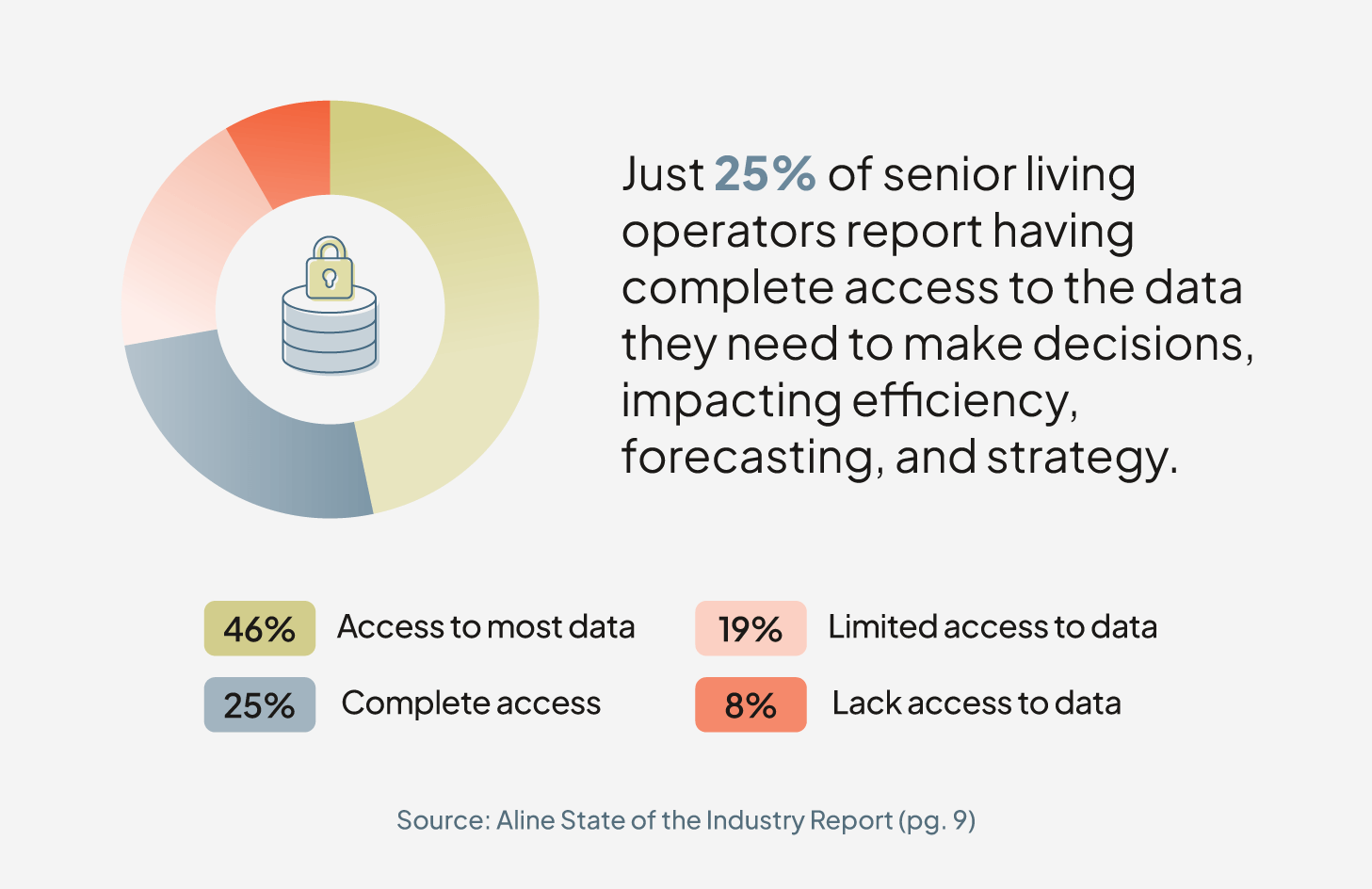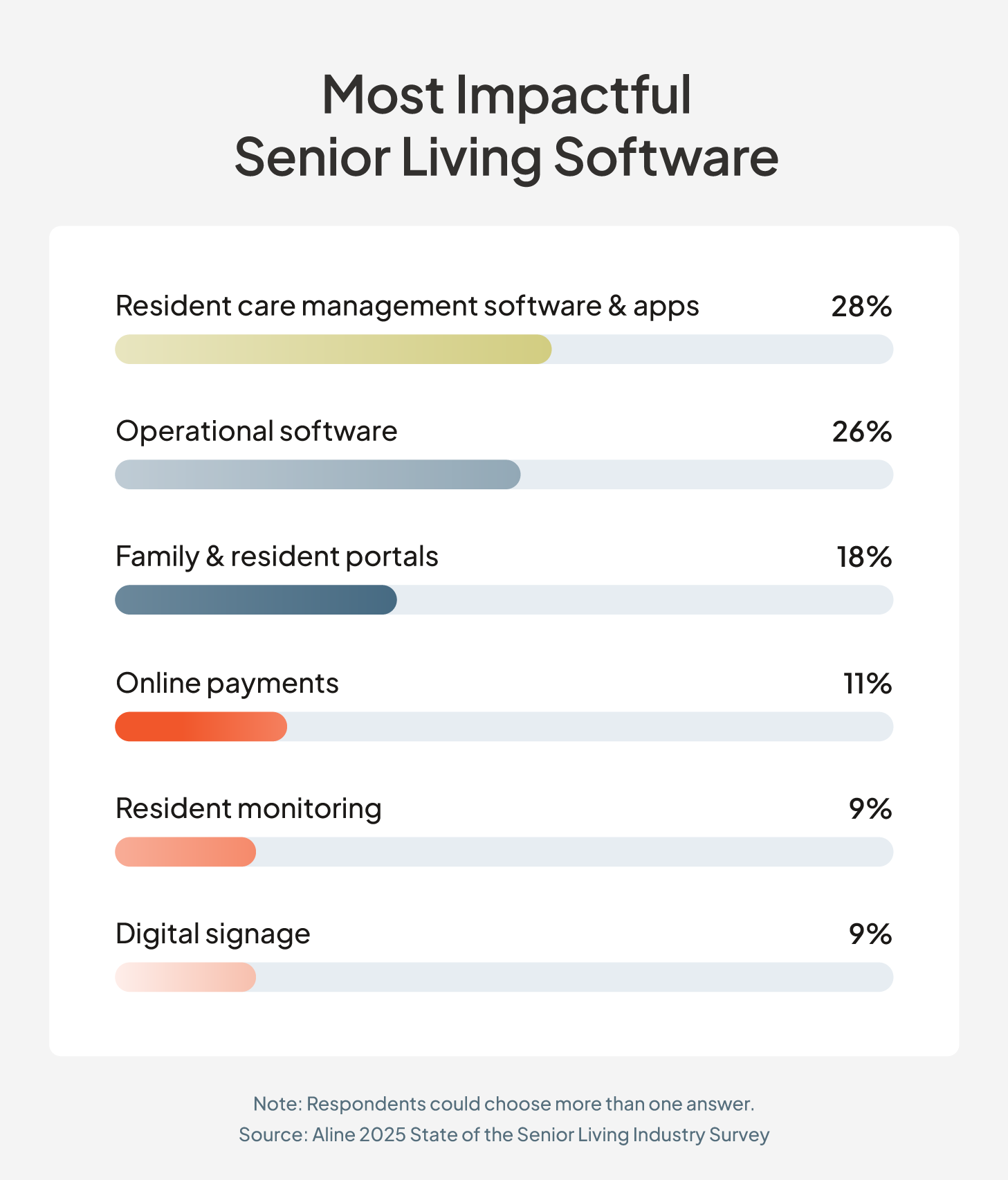Optimizing Your Senior Living Tech Stack: Point Solutions vs. Platforms
Take a look at how senior living software options, like Aline, can elevate operations, resident care, and ROI

Take a look at how senior living software options, like Aline, can elevate operations, resident care, and ROI
Published on: August 22, 2025
Last updated: September 11, 2025

Contents
Cobbled-together tech stacks consisting of various point solutions may work for a short period of time, but you may eventually find yourself struggling with inefficiencies that impact your bottom line. According to our 2025 State of the Industry Report, fragmented systems are one of the biggest challenges they face when improving operational efficiency.
Switching to a platform solution can pave the way for improved scalability and data-driven decision-making. Understanding the differences between point solutions and platform solutions — and how each affects your ability to grow and adapt — is key to making the right technology investment.
If you’re feeling the strain of disconnected systems and duplicate data entry, a platform solution offers a smarter, more sustainable path forward. Designed to unify operations, platform solutions bring powerful benefits that help senior living communities work more efficiently, scale with confidence, and provide better experiences for both residents and staff.
Primary operational benefit: Consistent, accurate data across your entire organization.
Platform solutions are purpose-built to break down data silos. Information entered in one module flows automatically and accurately to all other connected parts of the system, creating a reliable, organization-wide source of truth.
Example: When a sales representative enters demographic and health history data into the CRM, that same information automatically populates the preliminary health assessment. This allows the nurse to have an informed conversation with Mary about her current medications and ask targeted follow-up questions.
Once Mary moves in, her demographic details are already available in the billing system, eliminating the need for duplicate data entry. This not only saves time for the billing team, but it also ensures accuracy when submitting documentation to her insurance provider, leading to faster approvals and payments.
By streamlining data across departments, platform solutions make the resident onboarding experience smoother and more personalized while reducing staff workload and administrative errors. The result is more time for your team to focus on what matters most: elevating care.
Primary operational benefit: Time savings and fewer errors.
By connecting departments and streamlining workflows, platform solutions eliminate duplicate tasks, reduce manual errors, and improve coordination across teams. With one unified system, staff can work more efficiently, follow consistent processes, and spend less time on administrative work, freeing them up to focus on resident care and engagement.
Example: During her medication round, Emily, a caregiver, scans a barcode to confirm the correct dosage and records notes directly in the system. Those updates sync instantly across the eMAR and care management software, making them immediately visible to authorized team members. At the end of her shift, she assigns follow-up tasks to her replacement, Robert, directly within the platform, removing the need for a separate handoff meeting.
When Robert logs in, he sees a prioritized list of alerts and detailed notes from Emily’s shift, allowing him to take action without delay. This seamless communication ensures continuity of care, minimizes missed tasks, and enhances staff efficiency from one shift to the next.
Primary operational benefit: Improved resident outcomes and increased satisfaction.
Platform solutions provide a unified, 360-degree view of each resident by centralizing clinical, social, and administrative information. With all relevant data in one place — health history, dietary preferences, family communication, and billing — staff across departments can deliver more coordinated, personalized care.
Example: Resident Ava is diagnosed with a new health condition. Dr. Martin prescribes a new medication and recommends a specific diet and notes both in her care profile.
Instantly, Ava’s medication list is updated in the eMAR program to include the new medication and an order is placed with the pharmacy. Her new diet is flagged to the dining staff to personalize her daily menu options.
This streamlined, automated solution ensures that updates are made in real time for a smooth and quick care update across teams.
Primary operational benefit: More thorough, accurate reports in less time.
Platform solutions transform reporting and business intelligence by consolidating all operational data into a single, interconnected system. With data silos eliminated, you gain access to real-time, comprehensive insights that span departments and communities, allowing for more informed, strategic decision-making.
Customizable dashboards provide a clear view of key metrics — from sales inquiries and occupancy to clinical trends and billing activity — all in one place. Built-in analytics tools help identify patterns, monitor performance, and surface trends. Whether you need a high-level organizational snapshot or a granular look at a specific department, everything is accessible in just a few steps.
Example: When Garrett prepares for his monthly shareholder meeting, he logs into the platform and pulls exactly the data he needs within minutes. He can filter by department, community, or enterprise-wide performance and quickly spot trends with the help of built-in AI analytics to inform his presentation.
Primary operational benefit: Streamlined processes and stronger vendor relationships.
Platform solutions address multiple operational needs through a single provider, reducing the need to manage numerous third-party vendors. Rather than juggling separate contracts, billing cycles, and support contacts, you work with one centralized partner.
This consolidation simplifies administration, minimizes communication gaps, and fosters a more cohesive, responsive, and efficient relationship, ultimately saving time and ensuring your technology evolves in sync with your operational goals.
Primary operational benefit: Faster innovation and easier organizational growth.
Robust platform solutions are built to scale, offering the flexibility to support new communities, services, or care models as your organization evolves. Unlike point solutions, platforms can often integrate with emerging technologies without requiring a complete systems overhaul.
This adaptability allows you to innovate and expand confidently — knowing your tech stack is designed to grow with you and support long-term operational success.
Primary operational benefit: Higher morale and stronger retention.
Platform solutions simplify daily tasks, reduce administrative burden, and eliminate the frustration that comes with disjointed systems. When team members need resident information, whether clinical details or family contacts, they can find it quickly and reliably in one centralized place. No more wasted time searching across systems.
When technology works for your staff instead of against them, it enhances productivity and creates a more positive work environment. The result is twofold: improved morale and employee retention along with more consistent, higher-quality care for your residents.
While point solutions can be effective in the short term, managing multiple disconnected tools often leads to growing complexity, inefficiencies, and data silos. A platform solution becomes the smarter choice when your senior living organization is ready to move beyond patchwork fixes toward a more interconnected, scalable approach to technology and operations.
A platform is especially valuable in the following situations:
Leadership seeking deeper insights and smarter decision-making: When you need more than static reports, platform-based analytics deliver real-time insights, trend identification, and predictive capabilities that help you understand not just what’s happening but why.
Point solutions offer a highly focused approach to solving specific operational challenges within senior living communities. For many providers, they serve as a smart entry point into digital transformation or as a tactical solution for niche needs. In the right scenarios, point solutions deliver quick wins without requiring a major overhaul.
Ideal use cases for point solutions include:
Point solutions offer several distinct advantages that make them a strong fit in the right scenarios.
Because point solutions are built to address a single function, they often offer a level of depth and expertise that broader platforms may not. For example, an eMAR point solution focuses exclusively on medication administration, meaning its developers, support teams, and training materials are deeply specialized, offering more nuanced capabilities within that domain.
With a narrow focus, point solutions typically require fewer configurations and can be deployed more quickly. Their independence from other systems also minimizes disruption, reduces interdependencies, and shortens training and onboarding time. As a result, they’re ideal for communities looking for a fast, low-lift solution.
Due to their standalone nature, point solutions are easier to replace or upgrade without affecting the rest of your tech stack. If a CRM point solution no longer meets your needs, it can be swapped out with minimal impact to operations. Many vendors also update or adapt point solutions rapidly to integrate new features or technologies.
Because they target a single function, point solutions are typically more affordable upfront. You only pay for the features you need without subsidizing broader capabilities you may not use. Their streamlined development and support models also help vendors offer more competitive pricing.
While point solutions can offer quick wins and focused functionality, they often introduce long-term challenges, especially as your organization grows and operations become more complex.
When point solutions aren’t designed to integrate seamlessly, your tech stack can feel cobbled together. Disconnected systems lead to data silos, which result in duplicate data entry, errors, and time-consuming reconciliation efforts. Over time, this patchwork approach creates more administrative burden than it solves.
Disparate systems often create inconsistent workflows across departments. For example, using separate point solutions for care and billing can prevent timely communication about care plan changes, leading to missed charges, delayed invoicing, or revenue loss. These gaps hinder collaboration and reduce overall efficiency.
Without interconnected data, generating accurate reports becomes a manual, tedious process. Pulling information from multiple sources increases the risk of errors and slows down your ability to make timely decisions. At best, reporting becomes inefficient; at worst, decisions are based on incomplete or inaccurate data.

Managing multiple point solutions means juggling several vendors, contracts, billing cycles, and support teams. This adds administrative complexity and increases the risk of miscommunication or service delays—especially during critical issues or updates.
While point solutions may appear cost-effective upfront, the expenses associated with training, support, integration, and system maintenance can quickly add up. Over time, maintaining several disconnected systems may become more expensive than adopting a single, comprehensive platform.
As your organization grows, point solutions can hold you back. Different communities may adopt different tools for the same functions, leading to inconsistent processes and fragmented data. This lack of standardization limits your ability to scale efficiently and gain enterprise-level insights for strategic growth.
If your organization is running into these obstacles, it may be time to rethink your approach and explore how an interconnected platform can better support your long-term goals.
Many senior living operators have made smart, strategic investments in point solutions to address specific operational needs. These tools often deliver quick wins and solve targeted challenges. But as your organization grows and operations become more complex, the next natural step is transitioning to an interconnected platform.
The good news? Moving to a platform solution doesn’t have to be overwhelming. Start by evaluating whether your current point solution vendors offer complementary modules. Expanding within a familiar ecosystem can ease the transition and reduce friction for your team.
For example, if you already use Aline CRM, imagine the value of having resident lead data flow directly into Aline Care the moment a move-in occurs.
Or picture a care team member documenting a change in Aline Care with that update automatically reflected in Aline Leasing & Billing in real time. This isn’t just about linking software — it’s about interconnecting teams, streamlining workflows, and sharing data seamlessly to drive greater efficiency and consistency across your organization.

Transitioning to an interconnected platform doesn’t need to happen at once. In fact, trying to overhaul your entire tech stack overnight can be overwhelming and disruptive. A phased approach is often the most effective strategy.
Start by identifying your highest-priority pain points and rank them by impact. Then, gradually roll out platform modules that address those needs. This allows your team to adjust comfortably, see meaningful benefits at each stage, and build momentum toward a fully interconnected system without unnecessary disruption.
The right platform provider will support you through each phase of the transition. Many have worked with organizations just like yours and can offer guidance, training, and best practices to help your team succeed.
While the benefits of platform solutions are significant, you should consider and plan for potential challenges. Addressing these upfront will help ensure a smooth and successful transition.
Choosing between point solutions and a platform isn’t a matter of which one works. It’s about which one will continue working as your organization grows.
When the need for interconnected data, streamlined operations, holistic resident care, and meaningful business insights outpaces what your point solutions can deliver, a platform becomes the foundation for long-term success. With Aline, you can empower your team to scale efficiently, deliver exceptional care, and move forward with confidence.
Learn more about the trends, challenges, and opportunities for smarter senior living communities. Download our Software Buying Guide and discover how modern platforms can help you to achieve your goals.


Amanda McGrory-Dixon
Amanda McGrory-Dixon is the content marketing manager at Aline, where she shares expert insights on how senior living communities can streamline operations, enhance resident satisfaction, and drive sustainable growth. With a deep understanding of industry trends and technology, she helps operators navigate challenges and implement data-driven strategies to improve efficiency, profitability, and care outcomes.
Blogs, stories and studies from the forefront of senior living operations

Lead generation surveys give senior living operators the data they need to understand their market, uncover new opportunities, and drive occupancy growth.

Prospect-centered selling helps senior living operators convert more leads and achieve occupancy goals through a more personalized, empathetic approach.

Gain insight into senior living pricing strategies for community success. Explore how Aline’s software optimizes revenue and operations

Overcome the biggest senior living financial challenges, including operational costs and occupancy rates, with interconnected software

Enhance efficiency, accuracy, and resident satisfaction by integrating a POS system into your senior living dining operations

See how emerging dining strategies help senior living communities streamline operations while fostering stronger connections with residents
We’re using cookies on this site to improve your experience. Cookies help us learn how you interact with our website, and remember you when you come back so we can tailor it to your interests.
You can find out more about cookies and usage on our cookie policy page.
Some of these cookies are essential, while others help us to improve your experience by providing insights into how the site is being used.
For more detailed information on the cookies we use, please check our privacy policy
Your experience is important to us. We’re redirecting you to our new Aline website, where you’ll discover how our complete suite of senior living solutions can help you grow occupancy and revenue, optimize operations, and enhance resident care.
For more information, you’re welcome to read our statement on our merger. To continue your web experience, simply close this notification.
Your experience is important to us. We’re redirecting you to our new Aline website, where you’ll discover how our complete suite of senior living solutions can help you grow occupancy and revenue, optimize operations, and enhance resident care.
For more information, you’re welcome to read our statement on our merger. To continue your web experience, simply close this notification.
Your experience is important to us. We’re redirecting you to our new Aline website, where you’ll discover how our complete suite of senior living solutions can help you grow occupancy and revenue, optimize operations, and enhance resident care.
For more information, you’re welcome to read our statement on our merger. To continue your web experience, simply close this notification.
Your experience is important to us. We’re redirecting you to our new Aline website, where you’ll discover how our complete suite of senior living solutions can help you grow occupancy and revenue, optimize operations, and enhance resident care.
For more information, you’re welcome to read our statement on our merger. To continue your web experience, simply close this notification.
Aline Innovation Summit 2026: Registration Now Open!
Connect with senior living leaders, innovators, and industry peers May 11-13, 2026, in Frisco, TX to explore the latest innovations, proven strategies, and best practices shaping the future of senior living. View details and register today.